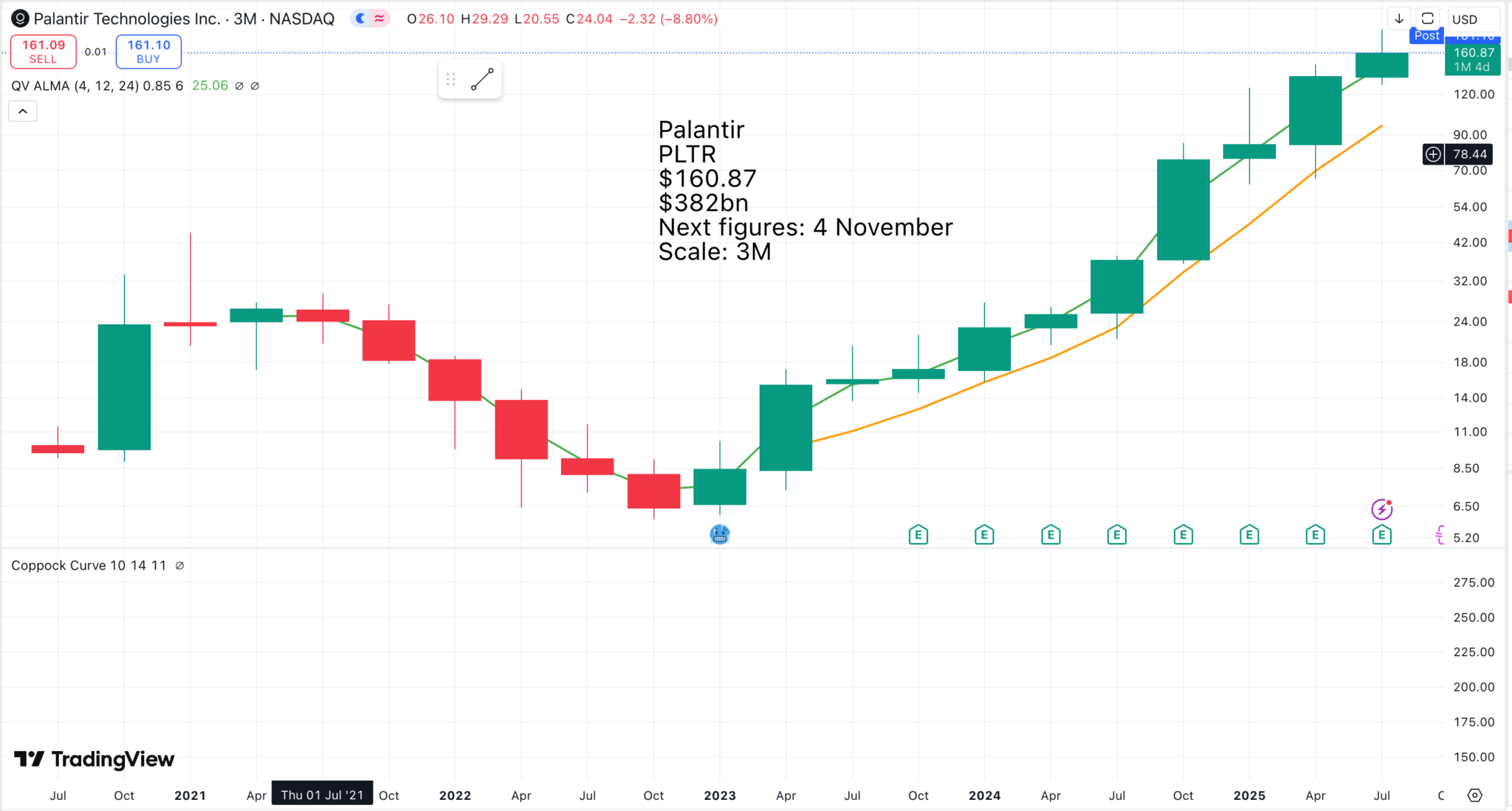

Subscribers know that I think Palantir is the greatest stock in the universe, alongside Nvidia, Broadcom, Credo Technology, Meta Platforms, Alphabet, Oracle and sundry other names. These are fantastic businesses operating against the background of one of the strongest tailwinds in economic history, an unfolding and accelerating technology revolution. Human life is at the dawn of a period of dramatic transformation, driven by the companies above and others, some not yet quoted.
Many analysts are convinced that excited investors have created a bubble, that these shares, led by Palantir, are overvalued and that the bubble is due to pop soon. That belief in itself is bullish because it means many sceptics have yet to be converted, but there are smart guys out there who agree with my bullish view.
When I last wrote about Palantir (NASDAQ:PLTR) (NEOE:PLTR:CA), I rated the stock a “buy,” as I believed that Palantir’s AIP (Artificial Intelligence Platform) is looking similarly positioned to how NVIDIA’s (NVDA) CUDA was at the start of the AI Revolution.
Since then, the company reported its Q2 FY25 earnings, which left investors speechless, as it not only managed to keep its revenue acceleration trend alive for 8 consecutive quarters in a row but also scored 94% in its Rule of 40 score, which is unmatched by any enterprise software company at the moment.
However, last week, after Sam Altman said that he believed that AI may be in a bubble, the stock shed over 15% of its market cap after reaching an all-time high price of $190 per share.
With fears of an AI bubble creeping back into markets again, I wanted to first emphasize that AI capex is far from reaching a peak, especially as spending shifts from training to inference with enterprises deploying AI at scale.
With a growing inference TAM (total addressable market), Palantir’s AIP becomes indispensable as its AI-native control layer embeds itself across the entire operating stack of a company, takes real-time data across systems, turns it into actionable simulations across business cases, and generates outsized ROI [return on investments] from its customers.
Second, while parallels to the dotcom bust are often drawn when talking about a potential AI bubble, I want to point out that today’s tech companies are much better grounded compared to the dotcom era, with rock-solid balance sheets and growing revenue and profitability.
Sure, Palantir’s forward valuation is the talk of the AI bear villa, but know that the company has been innovating while growing its profitability. In fact, since the beginning of the year, the management’s growth projection for its US Commercial Revenue has risen from 54% to 85% for the full year, while expecting greater margins.
While there are risks in the AI investment landscape, especially with growing capex depreciation expenses, which could hurt margins, along with a growing number of credit investors pouring billions of dollars into artificial intelligence investments lately, I believe there is no imminent danger as long as AI companies, such as Palantir and others, continue to meet and exceed earnings expectations, like they did in Q2.
With the tailwind of AI spending shifting to inference in the coming years, along with an accommodative monetary policy, it should support Palantir’s valuation multiple, especially as its forward revenue and earnings estimates are getting revised higher.
As a result, I will reiterate my “buy” rating on the stock with a price target of $190 per share at the moment.
Seeking Alpha, 25 Augsut 2025, Amrita Roy
Ms Roy has more exciting comparisons to make.
When it comes to Palantir’s Commercial Revenue, it is the US region that is responsible for contributing close to 68% of the segment’s revenue, growing at an eye-watering rate of 93% YoY, up from 71% in the previous quarter, with its US Commercial Customer count showing no signs of slowdown, growing 64% YoY to 485.
This is driven by none other than Palantir’s AIP, which Palantir’s CTO, Shyam Sankar, described as follows:
“AIP isn’t just software our customers use, it’s software, our customers are building their software on,” and highlighted accelerating adoption among frontline workers and rapid deployment of AI-driven solutions in U.S. industries.”
If you remember, in my previous post, I compared the indispensability of Palantir’s AIP in the second wave of the AI Revolution to the role Nvidia’s CUDA played in the first wave of the cycle.
Well, I fully stand by what I said earlier.
You can see it with the rate at which Palantir is closing its US Commercial deals over $1M and $5M in value, with US Commercial Total Contract Value growing at an accelerated rate of 222% YoY and the net dollar retention rate expanding sequentially to 128%, driven both by the expansion at existing customers and the acquisition of new customers.
Meanwhile, if you are thinking that Palantir is managing to grow at these rates while sacrificing profitability, you are wrong.
In my previous posts on Palantir, I had discussed that the company’s go-to-market model is centered on AIP Bootcamps and AIPCon to unlock potential AI use cases for existing and new clients instead of hoarding salespeople.
This model has allowed them to capture phenomenal economies of scale, where its adjusted operating margin beat expectations by 300 basis points at 46%, growing both on a sequential and year-over-year basis, as can be seen below.
Moving forward, Palantir’s revenue growth isn’t expected to slow down anytime soon, despite facing incredibly tough comps. For Q3, management expects revenue of $1.085B (in the midpoint), which would mark the 9th consecutive quarter of revenue acceleration at 50% YoY growth, which represents a year-over-year growth rate of close to 50% with a similar adjusted operating margin of 46%.
For the full year, the management now expects to generate total revenues of roughly $4.146B, with US Commercial Revenue projected to grow 85% and an adjusted operating margin of over 46%.
Just to give you a picture of the momentum of AIP, Palantir management has revised their full-year revenue guidance by over 10% since the beginning of the year, while expectations for the growth rate in the company’s US Commercial revenue have expanded by 3100 basis points during this period of time (from 54% at the start of the year to 85% as of the current quarter).
Seeking Alpha, 25 August 2025, Amrita Roy
Meanwhile, the tailwinds just get stronger.
However, since Palantir stock created an all-time high of $190 per share, it has shed more than 15% of its market cap over the last week.
This took place after OpenAI CEO Sam Altman said that the artificial intelligence market may be in a bubble. This is what he said below.
“When bubbles happen, smart people get overexcited about a kernel of truth. Are we in a phase where investors as a whole are overexcited about AI? My opinion is yes. Is AI the most important thing to happen in a very long time? My opinion is also yes.”
Unfortunately, since markets often have a very difficult time connecting dots, it quickly discounted the news from last month, where Sam Altman said that he plans to deploy 1M GPUs by 2025, while eyeing a 100-fold increase to 100M GPUs for AGI advancement.
While the path to 100M GPUs would require massive capital infusions of up to $3T or more, it makes one thing very clear. That is, the demand for AI compute isn’t going away anytime soon, which OpenAI’s CFO Sarah Friar further reiterated in a CNBC interview last week.
As a result, I believe the AI capex boom is far from reaching its peak.
According to Goldman Sachs, hyperscaler capex will increase sharply through 2027, with capex projected to be $1.15T from 2025 through 2027, more than double the $477B spent from 2022 through 2024.
In the most recent quarterly earnings, the four largest hyperscalers, which include Amazon (AMZN), Microsoft (MSFT), Alphabet (GOOG), and Meta (META), pointed out that their capex investments will exceed their prior estimates as compute capacity continues to remain constrained while the backlog of AI workloads continues to grow.
If you still need further evidence of the AI boom, check out the explosion in token usage across these companies, where Microsoft reported a 7x YoY growth rate in tokens served and processed by Foundry APIs, while Alphabet has doubled the number of tokens processed since May of this year.
The way I see it, this only means one thing.
The demand for inference is about to explode, like I have discussed several times in my previous posts on Palantir.
As Shay Boloor, Chief Market Strategist at Futurum Equities, pointed out in this Twitter post recently,
“This isn’t just about training LLMs. It’s about every enterprise app going AI-native. Every workflow, every vertical, and every user interface will need low-latency inference, secure data pipelines, and orchestration layers that simply don’t run on legacy infrastructure. It runs in the cloud—and it runs on clouds built for AI. So no, I don’t buy the “capex cliff” story. Not when enterprises are just beginning to fine-tune models and deploy agents into production.”
In other words, this is the time when Palantir’s AIP will increasingly become an indispensable layer in the AI operating stack, as it embeds itself across the entire operating stack of a company, takes real-time data across systems, turns it into actual simulations across business cases, and generates outsized ROI for their customers.
Here is the thing. We all may still be underestimating the amount of inference compute we need with Agentic AI, where enterprises deploy AI at scale across use cases.
As a result, you can see the magnitude of upward revisions in forward revenue that Palantir has received over the last 6 months (with no signs of slowdown).
Seeking Alpha, 25 Augsut 2025, Amrita Roy
I think what is freaking people out is that prospects are so exciting. It seems too amazing to be true, but what if it is true that the world is on the brink of a period of breathtaking change?
What is happening today is nothing like the 1990s dot.com bubble. I was there, and it was so different. Companies were hot air, smoke and mirrors, shares zooming higher because they had dot com in the name. Today is a different story.
Whenever the topic of the AI bubble emerges, investors quickly start to draw parallels between the current investment frenzy in artificial intelligence and the dot-com bubble in the late 1990s.
Since there is already plenty of available content on the dot-com bubble on the internet, I won’t repeat the mechanics of how the bubble and burst transpired in that era.
Instead, I am going to draw your attention to this chart below from Apollo Management’s Torsten Slok, where he says that the stock market’s expectations are even more unrealistic today, with 12-month forward price-to-earnings ratios now exceeding the peak of the dot-com bubble.
But here is the thing.
Of the top 10 companies by market capitalization today, eight are tech or communications behemoths. This contrasts with only five out of the 10 biggest companies that were tech firms back in 1999.
On top of that, the top 10 companies’ footprint in the S&P 500 is significantly higher today than it was in 1999, reflecting the fact that technology plays a much bigger role in the US economy today than it did at the turn of the millennium.
In the meantime, Palantir’s forward price-to-earnings multiple of 250 is not something to take lightly.
However, if we take the broader picture into account, the S&P 500 and Nasdaq are currently trading around 22 and 28.5 times forward earnings, compared with the dot-com peaks of 24.5 and over 70 times, respectively.
Plus, I firmly believe that the 1990s dot-com bubble was a lesson in unsustainable business models, where the bubble was characterized by a frenzy of public offerings, where stock prices of anything associated with a dot-com address skyrocketed, fueled by the fear of missing out.
That is not the case today. At least, not yet.
On the contrary, today’s top megacap tech companies trade at more balanced forward price-to-earnings multiples in my view, as there has been a shift away from “growth at all costs” to “growing profitably,” especially with interest rates elevated since 2022. On top of that, these industry giants have incredibly strong balance sheets, with historic levels of cash flows that are driving their AI investments.
Palantir is no different either.
The company has been innovating more by spending less, while their cash from operations has grown over 270% YoY with a margin expansion (as a percentage of revenue) of 3300 basis points to 54%.
Seeking Alpha, 25 Augsut 2025, Amrita Roy
This leads to her measured conclusion.
Palantir’s valuation is elevated, no doubt.
While I would not recommend going overweight on Palantir at these levels, especially if you are initiating a new position, I believe its valuation will remain supported as long as Palantir and companies in the AI investment landscape continue to meet investor expectations, despite risks of capex depreciation expenses and a growing number of credit investors pouring billions of dollars into the artificial intelligence investments.
As a result, I will reiterate my “buy” rating on the stock with a price target of $190, representing an upside of 20% from its current levels.
Seeking Alpha, 25 Augsut 2025, Amrita Roy
Well done, Ms Roy, for taking on the sceptics head-on. I think the outlook is even more exciting than she describes, but either way, buying into a volatile Palantir share price and that of other exciting tech names looks like an excellent and exciting strategy.
And now we have another excellent set of quarterly results from industry Behemoth, Nvidia, confirming that the AI boom continues to fire on all cylinders. China has become a major swing factor because of the politics but Nvidia’s argument for selling technology to China makes such sense that I am sure their view will prevail in the end.
In late July, the U.S. government began reviewing licenses for sales of H20 to China customers. While a select number of our China- based customers have received licenses over the past few weeks, we have not shipped any H20 based on those licenses. USG officials have expressed an expectation that the USG will receive 15% of the revenue generated from licensed H20 sales, but to date, the USG has not published a regulation codifying such requirement.
We have not included H20 in our Q3 outlook as we continue to work through geopolitical issues. If geopolitical issues reside, we should ship $2 billion to $5 billion in H20 revenue in Q3. And if we had more orders, we can bill more. We continue to advocate for the U.S. government to approve Blackwell for China. Our products are designed and sold for beneficial commercial use, and every license sale we make will benefit the U.S. economy, the U.S. leadership. In highly competitive markets, we want to win the support of every developer. America’s AI technology stack can be the world’s standard if we race and compete globally.
Colette Kress, CFO, Nvidia, Q2 2025, 27 August 2025
It is blindingly obvious that Nvidia is a phenomenal company in which every red-blooded investor should own shares.
As we continue to deliver both Hopper and Blackwell GPUs, we are focusing on meeting the soaring global demand. This growth is fueled by capital expenditures from the cloud to enterprises, which are on track to invest $600 billion in data center infrastructure and compute this calendar year alone, nearly doubling in 2 years. We expect annual AI infrastructure investments to continue growing, driven by the several factors: reasoning agentic AI requiring orders of magnitude more training and inference compute, global build- outs for sovereign AI, enterprise AI adoption, and the arrival of physical AI and robotics.
Blackwell has set the benchmark as it is the new standard for AI inference performance. The market for AI inference is expanding rapidly with reasoning and agentic AI gaining traction across industries. Blackwell’s rack scale NVLink and CUDA full stack architecture addresses this by redefining the economics of inference. New NVFP4 4-bit precision and NVLink 72 on the GB300 platform delivers a 50x increase in energy efficiency per token compared to Hopper, enabling companies to monetize their compute at unprecedented scale. For instance, a $3 million investment in GB200 infrastructure can generate $30 million in token revenue, a 10x return.
NVIDIA software innovation, combined with the strength of our developer ecosystem, has already improved Blackwell’s performance by more than 2x since its launch. Advances in CUDA, TensorRT-LLM and Dynamo are unlocking maximum efficiency. CUDA library contributions from the open source community, along with NVIDIA’s open libraries and frameworks are now integrated into millions of workflows. This powerful flywheel of collaborative innovation between NVIDIA and global community contribution strengthens NVIDIA’s performance leadership. NVIDIA is a top contributor to OpenAI models, data and software.
Colette Kress, CFO, Nvidia, Q2 2025, 27 August 2025
And then there are robots, which are obviously going to be massive.
Jetson Thor, our new robotics computing platform, is now available. Thor delivers an order of magnitude greater AI performance and energy efficiency than NVIDIA AGX Orin. It runs the latest generative and reasoning AI models at the edge in real time, enabling state-of-the-art robotics.
Adoption of NVIDIA’s robotics full stack platform is growing at rapid rate, over 2 million developers and 1,000-plus hardware software applications and sensor partners taking our platform to market. Leading enterprises across industries have adopted Thor, including Agility Robotics, Amazon Robotics, Boston Dynamics, Caterpillar, Figure, Hexagon, Medtronic and Meta.
Robotic applications require exponentially more compute on the device and in infrastructure, representing a significant long-term demand driver for our data center platform. NVIDIA Omniverse with Cosmos is our data center physical AI digital twin platform built for development of robot and robotic systems. This quarter, we announced a major expansion of our partnership with Siemens to enable AI automatic factories. Leading European robotics companies, including Agile Robots, NEURA Robotics and Universal Robots are building their latest innovations with the Omniverse platform.
Colette Kress, CFO, Nvidia, Q2 2025, 27 August 2025
If you want to become excited about prospects for the entire US stock market, not just Nvidia, listen to Jensen Huang, a colossus of the technology revolution, like Michelangelo or Leonardo Da Vinci in the Renaissance.
At the highest level of growth drivers would be the evolution, the introduction, if you will, of reasoning agentic AI. Where chatbots used to be one shot, you give it a prompt and it would generate the answer, now the AI does research. It thinks and does a plan, and it might use tools. And so it’s called long thinking; and the longer it thinks, oftentimes, it produces better answers.
And the amount of computation necessary for 1 shot versus reasoning agentic AI models could be 100x, 1,000x and potentially even more as the amount of research and basically reading and comprehension that it goes off to do. And so the amount of computation that has resulted in agentic AI has grown tremendously. And of course, the effectiveness has also grown tremendously. Because of agentic AI, the amount of hallucination has dropped significantly. You can now use tools and perform tasks. Enterprises have been opened up. As a result of agentic AI and vision language models, we now are seeing a breakthrough in physical AI, in robotics, autonomous systems. So the last year, AI has made tremendous progress and agentic systems, reasoning systems is completely revolutionary.
Now we built the Blackwell NVLink 72 system, a rack scale computing system, for this moment. We’ve been working on it for several years. This last year, we transitioned from NVLink 8, which is a node scale computing, each node is a computer, to now NVLink 72, where each rack is a computer. That disaggregation of NVLink 72 into a rack scale system was extremely hard to do, but the results are extraordinary. We’re seeing orders of magnitude speed up and therefore, energy efficiency and therefore, cost effectiveness of token generation because of NVLink 72.
And so over the next couple of years, you’re going to — well, you asked about longer term. Over the next 5 years, we’re going to scale into with Blackwell, with Rubin and follow-ons to scale into effectively a $3 trillion to $4 trillion AI infrastructure opportunity. The last couple of years, you have seen that CapEx has grown in just the top 4 CSPs by — has doubled and grown to about $600 billion. So we’re in the beginning of this build-out, and the AI technology advances has really enabled AI to be able to adopt and solve problems to many different industries.
Jensen Huang, CEO and co-founder, Nvidia, Q2 2025, 27 August 2025
Share Recommendations
Palantir. PLTR
Nvidia NVDA
Broadcom AVGO
Credo Technologies
Coreweave. CRWV
Meta Platforms
Alphabet GOOGL
Oracle ORCL
These are all Top 20 stocks.
Strategy – Keep Faith With The AI Boom
At the heart of the concerns about the durability of the AI boom is a raging debate about the future of Coreweave, one of my Top 20 stocks (now 24).
The AI-infrastructure company’s stock has been hammered on concerns over losses and debt. But Cantor Fitzgerald says CoreWeave is a ‘best-in-class’ player whose shares could climb to $116.
Investors were disappointed by a bigger-than-expected net loss in CoreWeave’s second quarter.
Shares of CoreWeave Inc. have fallen by more than 50% from their all-time highs. Is it a sign that the artificial-intelligence infrastructure company’s momentum is cooling, or is it just a bump on the road to further stock gains?
Cantor Fitzgerald analyst Thomas Blakey believes it’s the latter. He initiated coverage of CoreWeave’s stock (CRWV) on Tuesday with an overweight rating and a price target of $116.
CoreWeave’s stock has declined 40% since the company’s second-quarter earnings call on Aug. 12, when management announced a steeper loss than analysts were expecting. General concerns that the AI trade may be overextended have also dampened investor sentiment toward the sector.
However, Blakey believes the concerns are overblown. He calls CoreWeave a “best-in-class” player in the GPU-as-a-service market, which is projected to reach $399 billion in 2028. Cantor Fitzgerald’s industry checks indicate that CoreWeave is the leading AI-infrastructure provider and strategic partner, he said, outperforming peers with its offerings.
While few deny CoreWeave’s leadership, some analysts have reservations about the stock given execution risk surrounding customer concentration, financing and power supply. For instance, Needham analyst Mike Cikos recently cautioned investors to keep an eye out for CoreWeave’s “non-linear ramp to capacity versus revenue generation,” and D.A. Davidson analyst Gil Luria flagged CoreWeave’s heavy reliance on debt to drive growth.
As CoreWeave continues to build out data centers and purchase GPUs, it will have to prove to investors that it can scale its business to meet demand and lock down long-term contracts with clients. Blakey believes the company is on track to execute on its growth plans.
CoreWeave’s top two customers account for nearly 80% of its revenue, with Microsoft Corp. (MSFT) likely the largest customer, according to Blakey. However, the growth trends among CoreWeave’s top customers are robust, “driving near-term comfort in CoreWeave forecasts and customer concentration,” he wrote. Nvidia Corp. (NVDA) is also a customer and strategic partner and was an investor in CoreWeave’s March initial public offering, solidifying the company’s competitive advantage and providing CoreWeave with close access to the newest GPU hardware.
As CoreWeave’s revenue and backlog shift more from AI training to inference, Blakey sees a “larger market opportunity” for the company, which he said could be a “long-term driver.” Investors looking for more customer diversification should also note that the company’s acquisition of developer platform Weights & Biases in May “adds nearly 1,500 customers that CoreWeave can target to resell its compute services,” he added.
CoreWeave is also well-positioned to tackle the power bottleneck with its recently announced acquisition of Core Scientific Inc. (CORZ), which will provide access to 1.3 gigawatts of power through its national data-center footprint. Blakey believes this move will improve profitability and serve as a “near-term catalyst” for the stock.
In addition to providing power to help CoreWeave become less supply-constrained, the acquisition of Core Scientific also addresses investor concerns about CoreWeave’s financing costs. The transaction will give the company ownership over data centers instead of leasing them, helping save $10 billion in future lease liability overhead. The company has been making progress toward its goal of reaching investment-grade debt status in the coming years.
Some on Wall Street are taking a more cautious view on CoreWeave, but Blakey believes the company’s big bets on building out infrastructure and ramping up power will pay off down the road, making the stock’s pullback a buying opportunity.
MarketWatch, 28 August 2025, Christine Li
A golden rule of investing is that it pays to keep faith with your investments as long as the fundamentals remain exciting. This applies to all my Top 20 stocks. CoreWeave is like the inverse of MicroStrategy. The latter invests heavily in appreciating assets, Bitcoins, which generate no income. Coreweave invests heavily in rapidly depreciating assets, datacentres, which generate a handsome income.
Investors worry that Coreweave exists to take assets from their customers’ balance sheets and fund them with high-cost debt that it will struggle to service, let alone generate returns for its equity investors. We shall see. Meanwhile, it is growing at an incredible rate.
I have found that it usually pays to back management against the analysts. Coreweave’s management team are convinced they have a winning formula, and they are close to Nvidia, which is a shareholder and at the heart of the AI revolution.
My core belief, to coin a phrase, is that the appetite for compute capacity and hence datacentres/ AI factories is effectively limitless as planet earth becomes a giant computer dedicated to supporting the lives of the billions of humans scurrying about on its surface.
In a way, everything that has happened in tech so far has been a preparation for this moment as mankind begins to reach for the stars. It is no wonder that guys like Jensen Huang, Mark Zuckerberg, Elon Musk and Alex Karp are so excited. It is very exciting!
Footnote
I have just discovered that Sarah Friar has been the chief financial officer (CFO) of OpenAI since June 2024. No wonder the value of that business is rocketing, to around $500bn currently. Sarah Friar is a phenomenon. She was CFO at Square when the shares were in a meteoric ascent and has similar charisma to Jensen Huang. When she talks, you feel that anything is possible.
Something she has proved with her own career.
Born in 1972, Friar grew up in the town of Sion Mills in Northern Ireland.[7][1] She attended Strabane Grammar School.[8] Friar won a scholarship from the accounting firm Arthur Andersen after entering a competition; she then worked there for a year before pursuing engineering studies at University of Oxford.[9] She studied metallurgy, economics, and management at Oxford, and then completed an MBA from the Stanford Graduate School of Business where she was an Arjay Miller scholar.[1][10] Friar interned at Ashanti Goldfields in 1990s, during which she was assigned to work at a gold mine in Ghana.[11]
She was an analyst for McKinsey in South Africa,[12] a managing director in equity research at Goldman Sachs, and a senior vice president of finance and strategy at Salesforce[13] before becoming chief financial officer (CFO) at Square in 2012,[14][15][16] and then joining Nextdoor, a hyperlocal social networking service for neighborhoods, as the CEO in 2018. She led the company public through a special-purpose acquisition company In 2021.[17] Nextdoor announced Friar would step down as CEO in mid-2024.[18] In June 2024, she joined OpenAI, the artificial intelligence research organization that develops ChatGPT, as its first CFO.[2]
She is on the board of Walmart and ConsenSys,[19][20] and previously on Slack Technologies and New Relic‘s boards.[21] She also co-chairs Stanford’s Digital Economy Lab and runs Ladies Who Launch, a non-profit focused on female entrepreneurs that she co-founded.[22][23][5]
She received a honorary Doctor of Science degree from Ulster University in 2018.[24] In 2019, she was granted an Order of the British Empire from Queen Elizabeth II for her commitment to entrepreneurship and financial services.[
Wikipedia 2025
All this and she is still only 52. There will be fireworks when OpenAI goes public.



